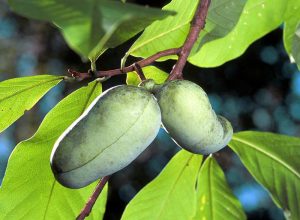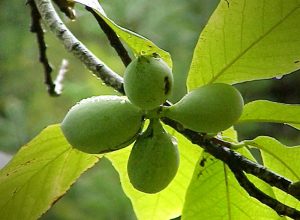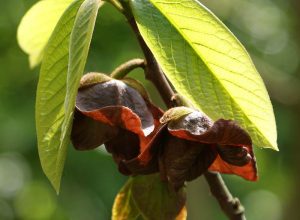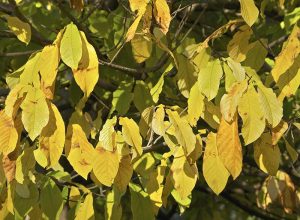Asimina Triloba


A beautiful plant belonging to the Anonoaceae family, which is almost exclusively a tropical plant and includes more than 100 species, of which the atypical Mountain Banana – Asimina made up of two species of fruit bearing plants which do well only in cold climates. One is the Asimina Paviflora, and is of little organoleptic interest, whilst the other, the Asimina Triloba produces many exquisite fruit.
Originally from the Eastern parts of the USA, where it grows spontaneously from Northern Florida regions to those of Canada- it is a, well known and very much appreciated by local people it’s called the paw-paw it is a small pyramid shaped tree with deciduous leaves. It can reach a height similar to that of a large peach tree, it has large lance shaped, pending leaves which are a beautiful deep green which in Autumn take on a splendid bright yellow which even at a distance renders the plant visible.
The plant is very resistant long periods of extreme cold, it can tolerate even temperatures of -30°C, which are essential to the formation of the flower buds, instead on the contrary to other plants in the Annonaceae, in very hot humid conditions the growth of the fruit can be impeded, but as it has a dense root system, made up of large roots, this can make the plant difficult to transplant.
TERRAIN
The Mountain is very rustic with few demands with regards to where planted. It easily adapts, although it tends to prefer an acid soil, as already said, it enjoys sub alkaline or even an alkaline soil it can rigorously thrive. Fundamental that the soil is deep, remember to make sure the soil is dense, and fresh, but more importantly there shouldn’t be any stagnant water.


FLORA AND FRUIT
The genre of the Asimina and the species of Asimina Triloba have for the most part self pollinating flowers; to bear fruit they receive the pollen from a plant of the same species. Prandini’s Nursery, apart from a variety of seeds, has only a variety of self pollinating cultivation, that is, a single plant can autonomously produce fruit. At the end of winter, before the leaves bud, numerous brown flowers bloom, similar to those of the Hamamelis or Witch Hazel. They bloom gradually during the course of a month and are characterized by an unpleasant putrid smell which is imperceptible to man, but not to bees which are not only not attracted to the flowers but actually avoid them.
The flowers also remain un-pollenated because of anemophile(via the wind) and above all because of the odour they emit, from the bothersome dipteral to the not very nice blowfly. Even if not very elegant and anything but pleasant., for an excellent pollination it is advised to place pieces of decomposing meat or fish under the plant during flowering, it will emit a characteristic odour which will attract blowflies and attracted by odour they will sit on the flowers thereby pollinating them.
The Asimina flowers have multiply ovaries, and so after the flowers have bloomed a few times diverse small fruit (7/8) attached to the same stalk. As the days pass though, much of the fruit will fall and only 2/4 per flower or simply only 1 will manage to reach maturity. During the first years of life, the Asimina Triloba, while flowing and producing small fruit, very few can manage to reach maturity; a discreet harvest can be obtained after a few years.
At the end of Summer/October depending on the variety and the cultivation zone, you will find big cylindrical fruit hidden by the beautiful leaves. They are light green with a very thin peel, which with the progress of maturity, speckle as the real banana does, then fall, having had a scaled and gradual flora the fruit also matures gradually and continues for about a month. The maximum organoleptic quality is reached the moment the fruit falls from the plant.
Of a few grams in weight, it has a creamy white Yellowish flesh, depending on its maturity, it has long, uniformed, dark seeds consistent to those of a large bean, and but not fastidious because the flesh easily separates from the seeds. The flavor of the mountain Banana is difficult to describe because it isn’t like anything we are used to. The flesh is creamy, aromatic and fragrant and recalls many flavours which range from the true banana, to pineapple, to cream to vanilla and varies according to stage of maturity, up to recalling the flavour of coffee at maximum maturity.
They are not climatic fruit (see Feijoa Selllowiana) and you can refrigerate them for a few days, plus once harvested they can be stored in notable quantities, they produce an elevated quantity of ethylene and carbon andriide that which makes the fruit difficult to store. Freezing it the fruit of the Asimina Triloba, does not lose any of its organoleptic characteristics, but loses its consistency becoming not very presentable.
Varieties of the Mountain Banana cultivated by prandini’s Nursery
- Asimina Triloba seeds: rarely self pollinating, the is the chance that the fruit is not aromatic, used for cuttings.
- Sunflower: from cuttings, self pollinating, produces constant medium to large sized fruit, excellent.
- Prima 1216: 1216 from cuttings, self pollinating, produce exquisite large fruit from its first years.
USE AND HEALTH PROPERTIES
In our Country the fruit is still little known and, considering the marketing difficulties, it’s only occasionally known on the greengrocer’s stall, so its use is addressed to direct consumption from those who own a plant. Quite different to its countries of origin where, apart from its fresh consumption, the fruit is largely used for garnishing cakes like our tarts, in the preparation of ice creams and marmalades and as a substitute to the real banana.
A fruit with a high nutritive power that is also very energetic, 100 grams provide eighty calories, like the real banana, and just like this, it’s difficult to digest: to consume relevant quantities could cause digestive problems. Due to the high quantity of magnesium contained and potassium, it’s an excellent saline supplement. Also important is the presence of iron, calcium and phosphorus, there is also a high amount of vitamin A. Of importance for quantity and quality is the presence of essential amino acids, that are those indispensable substances that the human body is not able to produce sufficiently and therefore, need to be necessarily integrated with nutrition. Known sportsman that have consumed a right quantity daily of this Mountain Banana, noticed a relevant improvement I their performances and a better physical well-being.
PRUNING AND CULTIVATION
Very easy plant: no need to do anything to it. Pruning isn’t required, if necessary, only that of restriction in the winter; provided that, it’s not planted in unpleasant terrain, just obvious watering is necessary, until satiated or in case of extreme drought and manuring is appreciated when planted. Ultimately a biological plant: as of today, fungal and parasite attacks by Asimina Trilloba are not known.
